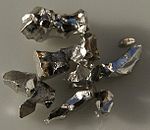- Group 9 element
-
Group → 4 ↓ Period 4 
27
Co5 
45
Rh6 
77
Ir7 109
Mt
Legend Transition metal Primordial element Synthetic
In modern IUPAC nomenclature, Group 9 of the periodic table contains the elements cobalt (Co), rhodium (Rh), iridium (Ir), and meitnerium (Mt). These are all d-block transition metals. All known isotopes of Mt are radioactive with short half-lives, and it is not known to occur in nature; only minute quantities have been synthesized in laboratories.Like other groups, the members of this family show patterns in its electron configuration, especially the outermost shells resulting in trends in chemical behavior, though rhodium curiously does not follow the pattern:
Contents
Chemistry
H He Li Be B C N O F Ne Na Mg Al Si P S Cl Ar K Ca Sc Ti V Cr Mn Fe Co Ni Cu Zn Ga Ge As Se Br Kr Rb Sr Y Zr Nb Mo Tc Ru Rh Pd Ag Cd In Sn Sb Te I Xe Cs Ba * Hf Ta W Re Os Ir Pt Au Hg Tl Pb Bi Po At Rn Fr Ra ** Rf Db Sg Bh Hs Mt Ds Rg Cn Uut Uuq Uup Uuh Uus Uuo * La Ce Pr Nd Pm Sm Eu Gd Tb Dy Ho Er Tm Yb Lu ** Ac Th Pa U Np Pu Am Cm Bk Cf Es Fm Md No Lr Group 9 in the periodic table Z Element No. of electrons/shell 26 cobalt 2, 8, 15, 2 44 rhodium 2, 8, 18, 16, 1 76 iridium 2, 8, 18, 32, 15, 2 108 meitnerium 2, 8, 18, 32, 32, 15, 2 Meitnerium has not been isolated in pure form, and its properties have not been conclusively observed; only cobalt, rhodium, and iridium have had their properties experimentally confirmed. All three elements are typical silvery-white transition metals, hard, and have high melting and boiling points.
History
Cobalt has been discovered in Egyptian and Persian artifacts from before the 2nd millenium BCE. Rhodium was discovered in 1803 when William Hyde Wollaston dissolved platinum ore in aqua regia, then neutralized the acid with sodium hydroxide. Wollaston then added ammonium chloride, and dissolved all metals except rhodium and palladium with the nitric acid in the aqua regia. Iridium was discovered in a very similar way in 1804 by Smithson Tennant. Meitnerium was discovered in 1982 by bombarding bismuth-209 with iron-58.
Occurrence
All group 9 elements are relatively rare in the earth's crust, with the most abundant, cobalt, only accounting for 0.0029% of the Earth's crust. Rhodium and Iridium are two of the rarest naturally occurring elements in the earth, only found in platinum ores. Meitnerium has only been produced in nuclear reactors and has never been observed in nature nor isolated in pure form.
Biological occurrence
Cobalt is an essential trace nutrient to all animals, found in vitamin B-12. Rhodium, Iridium, and Meitnerium have no known biological roles.
Applications
- Alloys with other metals, primarily to add corrosion and wear resistance
- Industrial Catalysts
- Superalloys
- Electrical Components
See also
Explanation of right side periodic table slice: Transition metals atomic number in black are solids solid borders are older than the Earth (Primordial elements) dashed borders have no isotopes older than the earth Periodic tables Layouts - Standard
- Large table
- Inline f-block
- Vertical
- Text only
- Metals and nonmetals
- Blocks
- Valences
- Extension beyond the 7th period
- Large extended table
- Electron configurations
- Electronegativities
- Alternatives
- Crystal structure
- Discovery periods
List of elements by - Name etymology (symbol)
- Discovery
- Oxidation state
- Abundance (in humans)
- Nuclear stability
- Hardness
- Atomic properties
- Production
Groups Other element categories - Periods
- Metals
- Transition metals
- Metalloids
- Nonmetals
- Lanthanides
- Actinides
- Rare earth elements
- Platinum group metals (PGMs)
- Post-transition metals
- Refractory metals
Blocks Periods Group 9 elements Cobalt
Co
Atomic Number: 27
Atomic Weight: 58.933195
Melting Point: 1768.15 K
Boiling Point: 3200 K
Specific mass: 8.86 g/cm3
Electronegativity: 1.88Rhodium
Rh
Atomic Number: 45
Atomic Weight: 102.90550
Melting Point: 2239.15 K
Boiling Point: 3968 K
Specific mass: 12.41 g/cm3
Electronegativity: 2.28Iridium
Ir
Atomic Number: 77
Atomic Weight: 192.217
Melting Point: 2716.15 K
Boiling Point: 4701 K
Specific mass: 22.56 g/cm3
Electronegativity: 2.2Meitnerium
Mt
Atomic Number: 109
Atomic Weight: 268
Melting Point: ? K
Boiling Point: ? K
Specific mass: 35 g/cm3
Electronegativity: ?Categories:- Periodic table
- Chemical element groups
Wikimedia Foundation. 2010.
